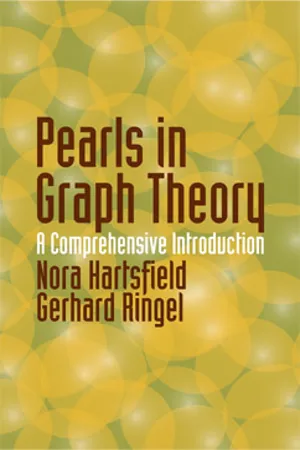
eBook - ePub
Pearls in Graph Theory
A Comprehensive Introduction
Nora Hartsfield, Gerhard Ringel
This is a test
- 272 pages
- English
- ePUB (adapté aux mobiles)
- Disponible sur iOS et Android
eBook - ePub
Pearls in Graph Theory
A Comprehensive Introduction
Nora Hartsfield, Gerhard Ringel
Détails du livre
Aperçu du livre
Table des matières
Citations
À propos de ce livre
`Innovative introductory text . . . clear exposition of unusual and more advanced topics . . . Develops material to substantial level.` — American Mathematical Monthly
`Refreshingly different . . . an ideal training ground for the mathematical process of investigation, generalization, and conjecture leading to the discovery of proofs and counterexamples.` — American Mathematical Monthly
` . . . An excellent textbook for an undergraduate course.` — Australian Computer Journal
A stimulating view of mathematics that appeals to students as well as teachers, this undergraduate-level text is written in an informal style that does not sacrifice depth or challenge. Based on 20 years of teaching by the leading researcher in graph theory, it offers a solid foundation on the subject. This revised and augmented edition features new exercises, simplifications, and other improvements suggested by classroom users and reviewers. Topics include basic graph theory, colorings of graphs, circuits and cycles, labeling graphs, drawings of graphs, measurements of closeness to planarity, graphs on surfaces, and applications and algorithms. 1994 edition.
`Refreshingly different . . . an ideal training ground for the mathematical process of investigation, generalization, and conjecture leading to the discovery of proofs and counterexamples.` — American Mathematical Monthly
` . . . An excellent textbook for an undergraduate course.` — Australian Computer Journal
A stimulating view of mathematics that appeals to students as well as teachers, this undergraduate-level text is written in an informal style that does not sacrifice depth or challenge. Based on 20 years of teaching by the leading researcher in graph theory, it offers a solid foundation on the subject. This revised and augmented edition features new exercises, simplifications, and other improvements suggested by classroom users and reviewers. Topics include basic graph theory, colorings of graphs, circuits and cycles, labeling graphs, drawings of graphs, measurements of closeness to planarity, graphs on surfaces, and applications and algorithms. 1994 edition.
Foire aux questions
Comment puis-je résilier mon abonnement ?
Il vous suffit de vous rendre dans la section compte dans paramètres et de cliquer sur « Résilier l’abonnement ». C’est aussi simple que cela ! Une fois que vous aurez résilié votre abonnement, il restera actif pour le reste de la période pour laquelle vous avez payé. Découvrez-en plus ici.
Puis-je / comment puis-je télécharger des livres ?
Pour le moment, tous nos livres en format ePub adaptés aux mobiles peuvent être téléchargés via l’application. La plupart de nos PDF sont également disponibles en téléchargement et les autres seront téléchargeables très prochainement. Découvrez-en plus ici.
Quelle est la différence entre les formules tarifaires ?
Les deux abonnements vous donnent un accès complet à la bibliothèque et à toutes les fonctionnalités de Perlego. Les seules différences sont les tarifs ainsi que la période d’abonnement : avec l’abonnement annuel, vous économiserez environ 30 % par rapport à 12 mois d’abonnement mensuel.
Qu’est-ce que Perlego ?
Nous sommes un service d’abonnement à des ouvrages universitaires en ligne, où vous pouvez accéder à toute une bibliothèque pour un prix inférieur à celui d’un seul livre par mois. Avec plus d’un million de livres sur plus de 1 000 sujets, nous avons ce qu’il vous faut ! Découvrez-en plus ici.
Prenez-vous en charge la synthèse vocale ?
Recherchez le symbole Écouter sur votre prochain livre pour voir si vous pouvez l’écouter. L’outil Écouter lit le texte à haute voix pour vous, en surlignant le passage qui est en cours de lecture. Vous pouvez le mettre sur pause, l’accélérer ou le ralentir. Découvrez-en plus ici.
Est-ce que Pearls in Graph Theory est un PDF/ePUB en ligne ?
Oui, vous pouvez accéder à Pearls in Graph Theory par Nora Hartsfield, Gerhard Ringel en format PDF et/ou ePUB ainsi qu’à d’autres livres populaires dans Mathematics et Mathematics General. Nous disposons de plus d’un million d’ouvrages à découvrir dans notre catalogue.
Informations
Sujet
MathematicsSous-sujet
Mathematics GeneralChapter 1

BASIC GRAPH THEORY
1.1 Graphs and Degrees of Vertices
Before we give any definitions and theory, let us consider the following example. There is a basket containing an apple, a banana, a cherry and a date. Four children named Erica, Frank, Greg and Hank are each to be given a piece of the fruit. Erica likes cherries and dates; Frank likes apples and cherries; Greg likes bananas and cherries; and Hank likes apples, bananas, and dates. Figure 1.1.1 describes the situation. The problem is to give each child a piece of fruit that he or she likes. The reader is invited to find a solution. One can see the advantage of using Figure 1.1.1 as an aid to solving the problem.
Figure 1.1.1 is, in fact, an example of a graph. Another example with which we are all familiar is a road map. The map in Figure 1.1.2 is greatly simplified, of course. It shows some different ways of driving from San Jose to San Francisco.

Figure 1.1.1

Figure 1.1.2
Chemists use diagrams to picture molecules, and these diagrams are also graphs. Usually the hydrogen atoms are omitted from the diagrams by the chemists using shorthand structure, but the Kekulé structure includes them.

Figure 1.1.3. Water, H2O.

Figure 1.1.4. Butane and isobutane, C4H10.
In Figures 1.1.6 and 1.1.7 the labels for carbon, hydrogen, and oxygen have been left out. See Figure 1.3.6 for another molecule C60.
Graph theory is used in designing printed circuits for use in electronics devices. Circuits printed on silicon chips must be designed differently from those using insulated wires, since the conducting portions cannot cross one another. The graph of Figure 1.1.8 shows part of a printed circuit used in a computer.
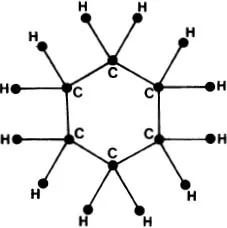
Figure 1.1.5. Cyclohexane, C6H12.

Figure 1.1.6. Aspirin, C9H8O4.
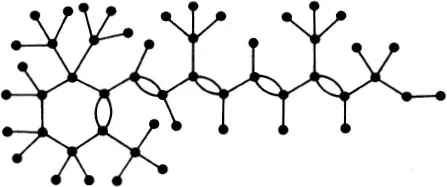
Figure 1.1.7. Vitamin A, C20H30O.
Algorithms can also be described by graphs. The graph of Figure 1.1.9 is a chart of the steps used in an algorithm for solving a certain problem using a computer.

Figure 1.1.8. Portion of a printed circuit

Figure 1.1.9
In the study of lattices and Boolean algebras, graphs arise as diagrams of these structures. Those who have studied set theory will recognize the diagrams of Figures 1.1.10 and 1.1.11 as lattices of subsets. For convenience, we use shorter notation for sets; for example, we write ABD for the set {A, B, D}. The diagrams of Figures 1.1.10 and 1.1.11 show all subsets of the set at the top. If one set is derived from another by deleting one element, then the two sets are connected by a line in the diagram.
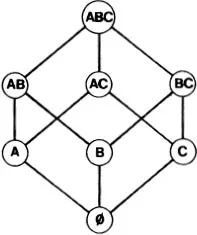
Figure 1.1.10. The lattice of subsets of ABC.
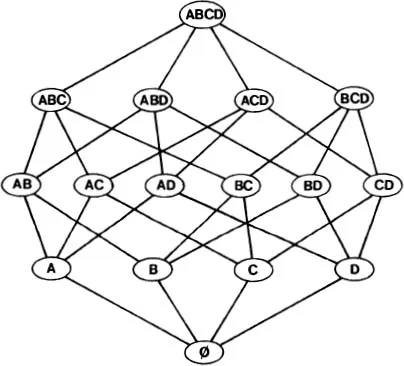
Figure 1.1.11
The different factorizations of the integer 60 are shown in the diagram of Figure 1.1.12. Some more examples of graphs are shown in Figures 1.1.13, 1.1.14, 1.1.15, 1.1.16, and 1.1.17.
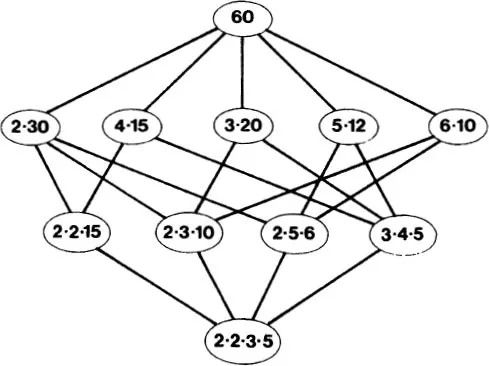
Figure 1.1....
Table des matières
Normes de citation pour Pearls in Graph Theory
APA 6 Citation
Ringel, G. (2013). Pearls in Graph Theory ([edition unavailable]). Dover Publications. Retrieved from https://www.perlego.com/book/112656/pearls-in-graph-theory-a-comprehensive-introduction-pdf (Original work published 2013)
Chicago Citation
Ringel, Gerhard. (2013) 2013. Pearls in Graph Theory. [Edition unavailable]. Dover Publications. https://www.perlego.com/book/112656/pearls-in-graph-theory-a-comprehensive-introduction-pdf.
Harvard Citation
Ringel, G. (2013) Pearls in Graph Theory. [edition unavailable]. Dover Publications. Available at: https://www.perlego.com/book/112656/pearls-in-graph-theory-a-comprehensive-introduction-pdf (Accessed: 14 October 2022).
MLA 7 Citation
Ringel, Gerhard. Pearls in Graph Theory. [edition unavailable]. Dover Publications, 2013. Web. 14 Oct. 2022.